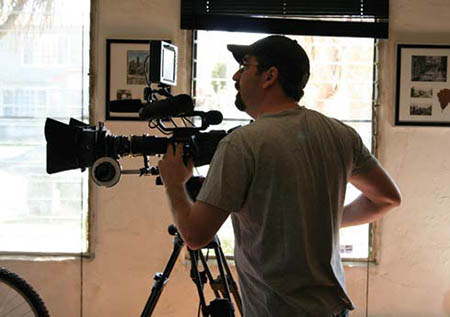Lighting: Back to Front Or Front to Back?
During a recent class at the Global Cinematography Institute in Hollywood, a student told me about a cinematographer he worked for who lit the background first, ignoring the actors until the last minute. I was co-teaching an independent cinematography class with Suki Mendencevic, ASC (“Poison Ivy II,” “I Hope They Serve Beer in Hell”). Both he and I confirmed that this was, indeed, a very common technique and each of us elaborated a bit on how and why.
For myself, I first encountered this idea working as a gaffer for my good friend Christopher Probst (“Detention,” “Fire With Fire,” and the upcoming “Beyond Skyline”), in our very early days in Hollywood. Chris and I rose through the ranks together and I would gaff when he was shooting and he would pull focus for me when I was shooting.
A METHOD TO THE MADNESS
It used to irritate the hell out of me that Chris would always start lighting from the smallest detail in the room. Some bookshelf in the far back corner is where he’d start, with some nook light or a puck light or skipping a Fresnel across the face of the shelves.
“What do you want to do about the actors?” I’d ask.
“I dunno...” he’d send back and continue to run around the room setting small fixtures and moving practicals.
I used to think, what a waste of time! We’re here to light the actors! It’s about the actors! We need to figure out what we’re going to do for them!
However, over time I began to see the wisdom in this technique. Setting the background helped to build an overall ambiance and helped to establish motivation for where light might come for the actors. Moving a practical to light up a corner of the room gave a motivation or an edge light or lighting up that bookshelf allowed for perfect separation for the actor in a moment where they could step out of any key into silhouette against that background. It was about building the world around the actors and then allowing them to exist within that world and augmenting to light them when everything else was firmly in place.
The professional video industry's #1 source for news, trends and product and tech information. Sign up below.
A PLAN IN PLACE

Despite initial misgivings, the author has adopted the philosophy of lighting the smallest details first. After working with Chris and getting to know this style of his, I actually started to adopt it a bit myself in my own lighting. There was great wisdom in first lighting the environment. Not only did it allow you to set motivation or sources, but it built up the base exposure and “room tone” and made lighting the actors a lot easier and more logical. Starting from the actor’s key light and going to the background was often like painting yourself into a corner. It became more of a task of trying to flag light off of areas and fighting spill rather than already having that world lit and putting in key lights that augmented the background.
Mendencevic brought up a very interesting point. As much of his career has been spent, like mine, in the independent and low-budget world, he looked at lighting from the background forward as a defensive move. The ASC cinematographer opined that the AD and production department will always rush you. If you have the actors lit then they can easily say “OK, we’re ready, you don’t have time to do the rest, let’s shoot!”
However, if you are lighting the background and haven’t lit the actors yet, they can’t just start shooting, they have to wait. It allows you more time to make sure you’re taking care of the image. “You have to have a whole plan in place,” he asserts. “But, for me, it’s easier to work in that way. It’s almost like painting. Many painters start with the furthest point first: the sky, then the sea, then the beach, then get to the details up close. I do the same with lighting, starting with the furthest point first and ending—and spending most of my time—on the details of the actors and the close up. Working from the background forward establishes a foundation for the lighting setup and often the background can stay the same as you’re moving from setup to setup where you’re just finessing the closeup lighting, so it’s also an efficient way of working.” There is no set formula or recipe; we do what is natural to us,” Mendencevic continues. “No matter how big or small your budget is, you’ll never be given all the time in the world, so you have to do what is most efficient to get the look you need.”
I can certainly relate with Mendencevic’s experience and his strategy. The only real danger is spending too much time on details and not leaving yourself enough time to take care of the actors, who, after all, are who the audience wants to see. I used to tease Probst that it was not a movie about a bookshelf, but I came to see the brilliance of his ways and have adopted the back-to-front technique for most of my cinematographic career.
Jay Holben is the author of the book “A Shot in the Dark: A Creative DIY Guide to Digital Video Lighting on (Almost) No Budget.” He can be reached via TV Technology.
